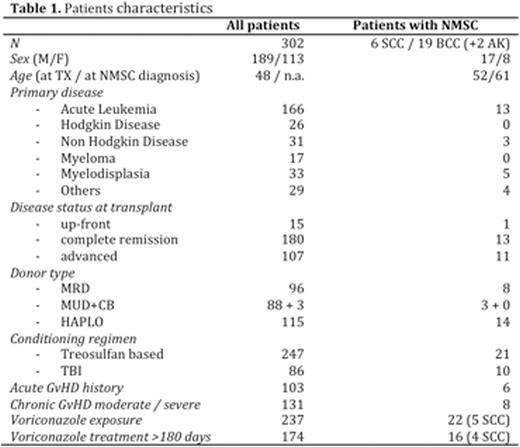Abstract
Introduction
Voriconazoleis a second-generationtriazolebroad-spectrum antifungal agent indicated in adults and children aged 2 years and above as treatment of invasive aspergillosis, treatment ofcandidaemiain non-neutropenic patients (pts), treatment of fluconazole-resistant serious invasive Candida infections, treatment of serious fungal infections caused byScedosporiumspp. and Fusarium spp.
Voriconazoleis associated with a broad spectrum of dermatologically adverse reactions: it seems to be responsible for a multistep process beginning with acute and chronicphototoxicity, followed by actinic keratosis (AK), and finally skin squamous cell carcinoma (SCC), especially if therapy is maintained. Strictphotoprotectionis mandatory; drug replacement by anothertriazolemust be discussed in case of acutephototoxicity.Voriconazolemust be stopped in pts with chronicphototoxicity, and a long-term dermatologic follow-up of skin lesions is required even after withdrawal.
It is now established thatvoriconazoleis an independent risk factor for the development of cutaneous malignancy in lung transplant recipients. Recently, a retrospective study from the Mayo Clinic (WojenskiDJ et al, Transplant Infectious Disease 2015, 17, 250-58) confirmed the association betweenvoriconazoleand SCC also after allo-HSCT (allogeneic hematopoietic stem cell transplantation) and identified cumulative days ofvoriconazoleas a risk factor for SCC.
Methods
The current study seeks to analyze the correlation betweenvoriconazoleexposure and non-melanoma skin cancer (NMSC) in our Center, where it is available an intensive dedicated follow-up after allo-HSCT to prevent and early detect second solid tumors.
Results
We analyze data prospectively collected at our Long-Term Follow-Up clinic between 2011 and 2016 including 302 adult pts with a minimum follow-up of 24 months. A written consent was given by pts allowing the use of medical records for research in accordance with the Declaration of Helsinki.
Baseline characteristics of the 302 pts are outlined in table 1. In total, 25 pts developed NMSC - median time from allo-HSCT 42 months (range, 9 months - 20 years) - median follow-up after NMSC diagnosis 2 years (range, 2 months - 12 years). The estimated cumulative incidence of NMSC at 3 years was 3.2% and at 5 years 6.2%.
At the dermatological annual evaluation 3 pts were presenting AK, only one progress to basal cell carcinoma (BCC), the 2 pts with AK are under dermatological follow-up. All pts were treated withvoriconazolefor more than 180 days.
In total 19 pts were diagnosed with BCC and 6 pts with SCC. Five pts with SCC and 17 with BCC were treated withvoriconazole, overall 16/22 (4 SCC) for more than 180 days. All pts were treated according to standard practice for NMSC, unfortunately 1 pts deceased due to SCC progression.
Only 2 pts were diagnosed and treated for NMSC before transplantation. Six pts had antecedent acute GvHD and 8 pts had antecedent moderate to severe chronic GvHD.
History ofvoriconazoleexposure, cumulative days ofvoriconazoleuse, gender, age at transplant, TBI based conditioning regimen, acute/chronic GvHD and skin cancer pre-transplant were considered for analysis. Age at transplant above 48 years (p <0.0001),voriconazoleexposure (p 0.0088) and cumulative days ofvoriconazoleexposure greater than 180 days (p 0.0038) were associated with higher risk of NMSC.
Conclusions
Our experience confirms the correlation betweenvoriconazoleand occurrence of NMSC after allo-HSCT. Incidence of NMSC is higher than previously reported in registry reports, and the occurrence of NMSC in pts exposed tovoriconazoleseems to be precocious. This observation confirms the relevance of counseling and prevention of NMSC in patients benefiting fromvoriconazoleas a crucialmold-active antifungal prophylaxis and treatment.
Bonini:Molmed SpA: Consultancy; TxCell: Membership on an entity's Board of Directors or advisory committees. Ciceri:MolMed SpA: Consultancy.
Author notes
Asterisk with author names denotes non-ASH members.


This feature is available to Subscribers Only
Sign In or Create an Account Close Modal